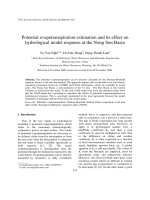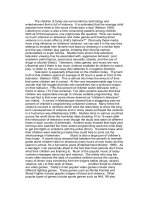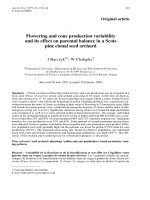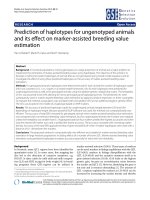Investigation of chaotic advection regime and its effect on thermal performance of wavy walled microchannels
Bạn đang xem bản rút gọn của tài liệu. Xem và tải ngay bản đầy đủ của tài liệu tại đây (12.15 MB, 178 trang )
INVESTIGATION OF CHAOTIC ADVECTION
REGIME AND ITS EFFECT ON THERMAL
PERFORMANCE OF WAVY WALLED
MICROCHANNELS
Hassanali Ghaedamini Harouni
(B. Sc. Isfahan University of Technology, Iran)
A THESIS SUBMITTED FOR THE DEGREE OF
DOCTOR OF PHILOSOPHY
DEPARTMENT OF MECHANICAL
ENGINEERING
NATIONAL UNIVERSITY OF SINGAPORE
2015
i
ii
Acknowledgements
I would like to express my gratitude to all those people who contributed in different ways
to this thesis. I am really grateful to my beloved parents and younger sister, Maryam, for
their supreme support and encouragement. Without them, my dream would not have
come true. I am particularly grateful to my supervisor Prof. Lee Poh Seng who guided me
in this study without imposing his personal viewpoint, but rather encouraging a fruitful
discussion and debate. And I would like to thank my co-supervisor, Prof. Teo Chiang
Juay for all the discussions and support.
I am very much pleased to acknowledge my colleagues and good friends, Mrinal,
Matthew and Bugra and specially our lab officer, Ms. Roslina, for their assistance and
support in the development of work in various ways.
I would also like to thank Lee Foundation for their support grant during the final semester
of my studies.
Hassanali Ghaedamini
January 2015
iii
Contents
ABSTRACT vi
List of Tables viii
List of Figures ix
Nomenclature xiv
Chapter 1. Introduction 1
1.1. Motivation 1
1.1.1. Thermal challenges of electronics 1
1.1.2. Thermal challenges of power electronics 4
1.2. Thermal management of electronics and power electronics 5
1.3. Cooling techniques 6
1.3.1. Two phase liquid cooling 7
1.3.2. Immersion cooling 8
1.3.3. Heat pipe technology 9
1.3.4. Thermoelectric (Peltier) coolers 9
1.3.5. Single phase liquid cooling 9
1.4. Heat transfer enhancement for single phase cooling 10
1.5. Objectives 11
1.6. Scope 12
1.7. Organization of the document 12
Chapter 2. Literature review 14
2.1. Corrugated channels for transport enhancement 15
2.2. Chaotic fluidics 20
2.3. Pulsatile flow 24
2.4. Unsteady flows in wavy walled architectures 25
2.5. Conclusion 28
Chapter 3. Problem definition and methodology 30
3.1. Physical description 30
3.2. Computational domains 33
3.3. Governing equations 35
3.4. Fluid flow as a dynamical system 36
3.4.1. Dynamical system 36
iv
3.4.2. Orbits and maps 37
3.4.3. Chaos theory through an example, Lorenz model 39
3.4.4. Chaotic advection 40
3.4.5. Poincaré map for wavy walled microchannels 42
3.5. Vortical structures 47
Chapter 4. Fully developed flow in wavy walled microchannels 49
4.1. Introduction 49
4.2. Geometry and cases simulated 49
4.3. Mathematical formulation and numerical procedure 50
4.4. Results and discussion 55
4.4.1. Vortical structures 55
4.4.2. Dynamical system point of view 56
4.4.3. Hydro-Thermal performance of the microchannel 57
4.4.4. Transition to chaos 68
4.4.5. Performance factor 70
4.5. Conclusion 72
Chapter 5. Developing Forced Convection in Converging-Diverging Microchannels
75
5.1. Introduction 75
5.2. Geometry and cases simulated 76
5.3. Mathematical formulation and numerical procedure 77
5.4. Results and discussion 79
5.4.1. Hydro-Thermal performance 79
5.4.2. Performance Factor 87
5.4.3. Effect of Re 89
5.4.4. Comparison with fully developed condition 94
5.5. Conclusion 95
Chapter 6. Experimental investigation of single phase forced convection in wavy
walled microchannels 97
6.1. Introduction 97
6.2. Experimental set-up and data reduction 98
6.2.1. Experimental loop 98
6.2.2. Test sections 99
6.2.3. Experimental procedure 103
v
6.2.4. Data reduction 103
6.3. Numerical simulations 106
6.3.1. Computational domain 106
6.3.2. Mathematical model 107
6.3.3. Boundary conditions 108
6.3.4. Domain discretization and solver control 109
6.4. Results and discussion 110
6.4.1. Thermal performance 110
6.4.2. Hydraulic performance 115
6.4.3. Heat fluxes range 117
6.5. Conclusion 118
Chapter 7. Enhanced transport phenomenon in small scales using chaotic advection
near resonance 120
7.1. Introduction 120
7.2. Geometry and cases simulated 121
7.3. Mathematical formulation and numerical procedure 122
7.4. Results and discussion 129
7.4.1. Overall Thermal-Hydraulic Performance 129
7.4.2. Local performance 131
7.4.3. Chaotic advection in converging-diverging microchannels 135
7.4.4. Chaotic advection near resonance 136
7.4.5. Effect of Re 138
7.4.6. Effect of conjugated condition 140
7.5. Conclusion 145
Chapter 8. Conclusion and recommendations for future works 148
8.1. Conclusion 148
8.2. Recommendations for future work 150
References 152
Appendix A: Uncertainty Analysis for Experimental Data 158
vi
ABSTRACT
Since the early works of Tuckerman and Peace [1], liquid cooling of electronics using
microchannel heat sinks has proven to be a viable solution for high heat dissipation rates
needed for modern electronics. While a microchannel heat sink has high heat transfer
area-to-volume ratio due to its small dimension, it also typically operates in the laminar
flow regime which is thermally less effective compared to the turbulence regime. Hence,
finding ways to enhance mixing and as a result heat transfer has been a topic of interest in
recent years.
Chaotic advection is a regime in which a laminar and well behaving Eulerian fluid field
shows chaos in its Lagrangian representation, i.e. chaotic and irregular pathline for fluid
particles. This concept is being used for enhancing the transport phenomenon in micro
scale devices like microreactors, micromixers and microchannel heat sinks. While
utilizing chaotic advection in micromixers through three dimensionally twisted shapes are
well established in literature, studying and characterizing planar designs for heat transfer
applications have not been extensively studied.
Wavy walled microchannels are believed to show chaotic advection as they force the
fluid elements to stretch and fold due to the three dimensional vortical structures formed
in them. For a converging-diverging shape, which is studied in this thesis, these vortical
structures are four streamwise vortices at the corners of the contraction part of the furrow
and two counter rotating vortices in the trough region of the furrow. Our geometrical and
flow parametric study on the converging-diverging configuration shows that chaotic
advection is indeed present in this converging-diverging design. However, chaotic
advection becomes stronger at higher Re and/or for highly modulated channels. Strong
chaotic advection shows itself with an asymmetric Poincaré map and also a sharp
increase in the heat transfer and pressure drop behaviors.
vii
Along with the numerical investigations on the parametric space for both fully developed
and developing conditions, experiments were performed to validate the numerical results.
Converging-diverging microchannel heat sinks were designed with the microchannels
being machined on a 2.5 cm by 2.5 cm footprint area with possible application in
electronics cooling. Different levels of wall waviness and Reynolds number up to 800
were studied. A good agreement between the numerical results and the experiments was
observed which further validates the numerical approach.
The numerical and experimental results show that high heat transfer rates due to the
presence of strong chaotic advection is indeed achievable with converging-diverging
microchannel heat sinks albeit with high pressure drop penalties. Thus, in the last chapter
the concept of chaotic advection near resonance is introduced to enhance heat transfer at
relatively lower pressure drop tradeoff by achieving a strong chaotic advection regime for
slightly modulated channels and at relatively smaller Reynolds numbers. Heat transfer
enhancements of up to 70% are observed with this novel method while the pressure drop
penalty was lower than 60%.
Our results confirm that the converging-diverging microchannel design is a very good
candidate for passive and active heat transfer augmentation. Especially considering that
almost all the micro-pumps are inherently pulsatile, the concept of chaotic advection near
resonance introduced in this thesis can certainly find applications in microscale thermal
systems. In addition, wavy walled microchannel heat sinks show a more uniform
temperature distribution compared to the straight design. Since heat transfer is a strong
function of wall waviness, such a design can be used for conditions with non-uniform
heat flux distribution and also for hot spot mitigation.
viii
List of Tables
Table 4-1. Non-dimensional geometrical parameters of the cases simulated. 50
Table 4-2. Thermo-physical properties of water 51
Table 4-3. A typical mesh independence study. 54
Table 4-4. The comparison between the analytical and numerical values of Nu and fRe for
the straight microchannel with S = 1. 55
Table 5-1. Non-dimensional geometrical parameters of the cases simulated. 76
Table 5-2. Thermo-physical properties of water 78
Table 6-1. Dimension of the test pieces experimented. 102
Table 7-1. Thermo physical properties of water. 122
Table 7-2. Grid independence study results. 124
Table 7-3. Fluid flow parameters for the cases studied in the first part. 126
Table 7-4. Fluid flow parameters for the cases studied in the second part. 126
Table 7-5. Nusselt number and friction factor for the cases with Re = 300. 131
ix
List of Figures
Figure 1-1. Moore’s law, CPU transistor counts against dates of introduction. 2
Figure 1-2. 35 years of microprocessor trend data [9], Original data collected and plotted
by M. Horowitz, F. Labonte, O. Shacham, K. Olukotun, L. Hammond and C. Batten.
Dotted line extrapolations are done by C. Moore. 3
Figure 1-3. Schematic view of microchannel heat sink for 3D stacked dies. 4
Figure 1-4. The block diagram of power electronics systems. 5
Figure 1-5. A schematically drawn packaging of an IGBT module. 6
Figure 1-6. Different wavy walled microchannel configurations. 11
Figure 2-1. Friction factor relation with Re. Flow patterns [33]. 16
Figure 2-2. a) Experimental setup and position of electrodes. b) Average Sherwood
number. c) Comparison of Sherwood number for wavy and straight channel. [34] 17
Figure 2-3. Three dimensional configuration of micromixers invoked in [60]. 21
Figure 2-4. Streamwise and crosswise velocities as a function of time. Fourier power
spectra of the u velocity, and state space trajectories of v vs u for the converging-
diverging channel flow: a) periodic b) quasi-periodic c) chaotic behavior. [66] 22
Figure 2-5. Flow diagram proposed by Sobey[83] for a sinusoidal wavy walled channel.
26
Figure 2-6. Experimental test section and Sherwood number vs. Re for symmetric and
asymmetric channels. [92] 28
Figure 3-1. a) Physical configuration. b) Wavy walled microchannel heat sink. c) Key
dimensional parameters. 30
Figure 3-2. A typical configuration with S = 0.8 and different level of wall waviness. The
equivalent straight microchannel is the one with λ = 0 for all the cases. 32
Figure 3-3. Computational domain for fully developed condition. 33
Figure 3-4. Computational domain for developing flow with constant temperature
boundary condition. 33
Figure 3-5. Computational domain for conjugated condition. 34
Figure 3-6. Computational domain for study of pulsatile flow in wavy walled channels. a)
single channel with constant temperature boundary condition. b) conjugated domain with
constant heat flux at solid boundary. 34
Figure 3-7. Orbit of periodic and chaotic dynamics for a three dimensional system. 38
Figure 3-8. Poincaré map related to a typical 3D dynamical system. 39
x
Figure 3-9. Temporal evolution of two initial conditions deviated by 0.005 based on the
Lorenz equations for a regular dynamic (left) and a chaotic dynamic (right) 40
Figure 3-10. Poincaré maps for developing flow condition. 44
Figure 3-11. A typical Poincaré map for fully developed condition. 45
Figure 3-12. Poincaré maps for the problem of stirring in a tank for two advection
regimes, regular and chaotic [57] 46
Figure 3-13. Typical Poincaré maps for pulsatile flow in converging-diverging
microchannels. 47
Figure 3-14. A typical vortical structure shown by iso-surfaces of swirling strength.
Vector plot shows the presence of a vortex near the region which is indicated by the
isosurface. 48
Figure 4-1. Vortical structure evolution as the result of increment in (a) Re and (b) wall
waviness λ. 56
Figure 4-2. Poincaré maps for the case with S = 1 and λ = 0, 0.05, 0.1 and 0.15 at Re =
200, 400 and 600 58
Figure 4-3. Typical KAM tubes for the cases with a) symmetric KAM tubes b)
asymmetric KAM tubes. 59
Figure 4-4. Nu as a function of waviness λ and channel expansion factor γ. 59
Figure 4-5. fRe as a function of waviness λ and channel expansion factor γ. 60
Figure 4-6. Nu as a function of wall waviness and aspect ratio for Re = 200 61
Figure 4-7. Nu as a function of wall waviness and aspect ratio for Re = 400 61
Figure 4-8. Nu as a function of wall waviness and aspect ratio for Re = 600 62
Figure 4-9. Vortical structures and temperature contours for the case with S = 1.5 at four
levels of wall waviness and three Re 64
Figure 4-10. fRe as a function of wall waviness for Re = 200. 66
Figure 4-11. fRe as a function of wall waviness for Re = 400. 66
Figure 4-12. fRe as a function of wall waviness for Re = 600. 67
Figure 4-13. Friction factor as a function of channel expansion factor γ. 68
Figure 4-14. Temporal value of Nu and fRe for the three aspect ratio of S = 0.5, 0.8, 1. 69
Figure 4-15. PF as a function of wall waviness for: (a) Re = 200, (b) 400 and (c) 600. (d)
PF as a function of channel expansion factor, γ. 71
Figure 5-1. Computational domain. a) Converging-diverging configuration; b) its
equivalent straight microchannel; c) geometrical dimensions of the microchannel. 77
Figure 5-2. Developing Nusselt number as a function of waviness for Re = 200. 80
xi
Figure 5-3. Middle plane temperature contours. Central four furrows are presented in this
figure. 82
Figure 5-4. Vortical structure formation as a function of waviness. Flow direction is from
left to right. 82
Figure 5-5. Poincaré map position. Particles are released along the red line in the middle
of the inlet 85
Figure 5-6. Poincaré map for the cases with Re = 200. 86
Figure 5-7. Friction factor as a function of waviness λ for the cases with Re = 200 87
Figure 5-8. Performance factor as a function of waviness λ for the cases with Re = 200. 88
Figure 5-9. Developing Nusselt number as a function of waviness for Re = 400. 90
Figure 5-10. Developing Nusselt number as a function of waviness for Re = 600. 91
Figure 5-11. Wall shear stress contour for Re = 200 91
Figure 5-12. Poincaré map for the cases with Re = 400. 92
Figure 5-13. Poincaré map for the cases with Re = 600. 93
Figure 5-14. Performance factor as a function of waviness λ for the cases with Re = 400.
93
Figure 5-15. Performance factor as a function of waviness λ for the cases with Re = 600.
94
Figure 5-16. Nu and f for a) developing and b) fully developed condition for Re = 200. .95
Figure 6-1. Schematic diagram of the flow loop. 99
Figure 6-2. a) Test piece schematic diagram. Location of the thermocouples and pressure
transducer are presented. b) Actual manifold and the test piece. 100
Figure 6-3. Converging-diverging architecture with the main geometrical parameters
being presented. 101
Figure 6-4. Position of thermocouples and the cartridge heaters in the copper block. 102
Figure 6-5. Computational domains for the simulations. a) Computational domain for a
single channel with constant temperature boundary condition. b) Computational domain
for a single construct with symmetric boundary conditions. 107
Figure 6-6. Grids being used for a) the conjugated simulation and b) constant temperature
boundary condition. 109
Figure 6-7. Nu as a function of Re for the straight configuration case, λ = 0. 111
Figure 6-8. Nu as a function of Re for the slightly modulated case, λ = 0.05. 112
Figure 6-9. Nu as a function of Re for the moderately modulated case, λ = 0.10. 113
Figure 6-10. Nu as a function of Re for the highly modulated case, λ = 0.15 114
xii
Figure 6-11. Poincaré sections for the cases with λ = 0.05 and λ = 0.10 at Re =200 and
700. 114
Figure 6-12. f as a function of Re for straight microchannel, λ = 0. 115
Figure 6-13. f as a function of Re for the slightly modulated case, λ = 0.05. 116
Figure 6-14. f as a function of Re for the moderately modulated case, λ = 0.10 116
Figure 6-15. f as a function of Re for the highly modulated case, λ = 0.15. 117
Figure 6-16. Dissipated Heat flux as a function of pumping power. T
in
= 20°C. 118
Figure 7-1. Grids being used for the pulsatile flow in wavy walled microchannel study.
124
Figure 7-2. Temporal grid independence study. 125
Figure 7-3. Nusselt number variation as a function of pulsation frequency and pulsation
amplitude for Re = 300. 129
Figure 7-4. Friction factor variation as a function of pulsation frequency and pulsation
amplitude for Re = 300. 130
Figure 7-5. Temporal value of (a) Nusselt number and (b) friction factor for the cases
with Re = 300 and 40% pulsation amplitude. 132
Figure 7-6. Temperature contours of furrow #6 of the channel at different time intervals
for Re = 300 and 40% pulsation amplitude for two frequencies of (a) 40Hz and (b)
100Hz. 134
Figure 7-7. Local value of spatially and temporally averaged Nusselt number for the case
with Re = 300 and pulsation amplitude of 40%. 135
Figure 7-8. Poincaré map at four time intervals for the cases with Re = 300, pulsation
amplitude of 40% and pulsation frequency of (a) 5 Hz, (b) 40 Hz and (c) 100 Hz. 137
Figure 7-9. Nusselt number and friction factor variation as a function of pulsation
frequency and pulsation amplitude for Re = 100, 300 and 700. 139
Figure 7-10. Time averaged Nusselt number, friction factor and maximum temperature in
the solid as the function of pulsation frequency for the case with 13% pulsation amplitude
and Re = 300. 140
Figure 7-11. Time averaged Nusselt number, friction factor and maximum temperature in
the solid as the function of pulsation frequency for the case with 40% pulsation amplitude
and Re = 300. 141
Figure 7-12. Time averaged Nusselt number, friction factor and maximum temperature in
the solid as the function of pulsation frequency for the case with 70% pulsation amplitude
and Re = 300. 142
xiii
Figure 7-13. Thermal resistance as a function of pulsation frequency and pulsation
amplitude. 144
Figure 7-14. Figure of merit as a function of pulsation frequency and pulsation amplitude
145
xiv
Nomenclature
A wavy wall amplitude, m
A
cb
bottom area of a single channel, m
2
A
cs
side wall area of a single channel, m
2
A
FP
footprint area, m
2
A
HT
heat transfer area, m
2
a average width of the channel, m
b channel depth, m
C
p
specific heat capacity, J/kgK
D
h
hydraulic diameter of the averaged cross section, m
DAQ data acquisition system
f friction factor
f
p
pulsation frequency, Hz
Δf variation in friction factor
FOM figure of merit
h heat transfer coefficient, W/m
2
K
IGBT insulated-gate bipolar transistor
ITRS International Technology Roadmap for Semiconductors
k thermal conductivity, W/mK
L wavy wall wavelength, m
m
mass flow rate, kg/sec
N number of furrows
Nu Nusselt number
N
t
number of time steps in one pulsation period
ΔNu variation in Nusselt number
M number of channels
P pressure, Pa
ΔP pressure drop, Pa
xv
PF performance factor
PP pumping power, W
Q heat transfer rate, W
q
heat flux, W/m
2
R thermal resistance, K/W
Re Reynolds number
S aspect ratio of the equivalent straight microchannel
S
aspect ratio of the narrowest part of the microchannel
S
w
fin thickness, m
S
v
vertical distance of the thermocouples to the base of microchannels, m
T temperature, K
ΔT
lm
logarithmic mean temperature difference, K
t time, s
Δt time step, s
U inlet velocity, m/s
U
m
averaged velocity of the equivalent straight microchannel, m/s
UPS uninterruptible power supply
V
volumetric flow rate, m
3
/s
u,v,w velocity components, m/s
x,y,z coordinates, m
Greek symbols
Β pressure gradient, Pa/m
γ expansion factor
θ scaled temperature
λ waviness
μ dynamic viscosity, Pa s
ρ density, kg/m
3
τ forced pulsation period, s
xvi
w
wall shear stress, Pa
Subscripts
0 steady component
b bulk
Cu copper
f fluid
in inlet
m mean
max maximum
out outlet
p pulsatile component
s solid
ss steady state component
w wall
1
Chapter 1. Introduction
Tuckerman and Pease [1] introduced the idea of liquid cooling of electronics in 1981.
Since then, thermal management of electronics and power electronics has been the main
driver for microchannel heat sink technology [2]. However, it should be noted that the
concept being developed in this thesis can find its way into different industrial sectors
like thermal management of LEDs [3], lasers [4] and micro-scale heat exchangers [5].
1.1. Motivation
1.1.1. Thermal challenges of electronics
Moore’s law is closely related to thermal management of electronics [6]. Named after
Gordon E. Moore, it states that the number of transistors in a dense integrated circuit (IC)
doubles approximately every two years, as shown in Figure 1-1. More transistors means
faster computation, higher power consumption for electronics and hence larger heat
fluxes to be dissipated. In the 2003 report of ITRS, International Technology Roadmap
for Semiconductors, the need for thermal management of electronics with heat fluxes up
to 100 W/cm
2
was heavily emphasized [7]. However, the newer report of ITRS published
in 2013 has minimal concerns regarding the high heat flux management and the emphasis
is mostly on hot spot mitigation, co-design of chips and the multi-disciplinary (thermal,
mechanical and electrical) considerations of packaging materials. This is due to the fact
that the trend in designing the processors has changed in recent years whereby instead of
increasing the speed of the processors, multi-core strategy is being adopted by the
semiconductor industry. This multi-core strategy has suppressed the issue of overheating
of the computing units and in this way air cooling is still a valid solution for personal
computers despite the concerns people had in 2003. Figure 1-2 shows the trend of micro-
2
processor data in the past 35 years. The speed of processor is still around 3 GHz while
core number has increased, at the same time the typical power consumption of a CPU has
been around 100 W.
Figure 1-1. Moore’s law, CPU transistor counts against dates of introduction.
Unlike personal computers, liquid cooling is a common solution for super computers and
server farms due to several advantages over air cooled systems. These include: cost
effectiveness, more compact designs, more efficient systems and quieter operation.
Cooling is a huge fraction of power consumed by supercomputers. As an example, the
newest Chinese super computer, Milkyway-2, consumes 24 megawatts of which 6
megawatts are for its closed loop water cooling system [8]. A recent study done in 2014
by HIS, a market research firm, reveals that even Data Centers are migrating towards
3
liquid cooling with a market size of $2.3 billion in 2014 which is anticipated to double in
just two years at the current growth rate.
Figure 1-2. 35 years of microprocessor trend data [9], Original data collected and
plotted by M. Horowitz, F. Labonte, O. Shacham, K. Olukotun, L. Hammond and
C. Batten. Dotted line extrapolations are done by C. Moore.
Trends regarding the market demand and technical limitations of air cooling point out the
importance of liquid cooling for electronics industry. The newer generation of ICs with
14nm technology is anticipated to hit the shelves in the second quarter of 2015 which
answering their thermal management demand can be a challenge to engineers and
designers.
There is also a paradigm shift taking place from traditional packaging hierarchy to 3D
packaging configurations [10]. The three dimensional chip stacks thermal challenges
include:
Sizable increase in the number of power dissipating devices with a typical heat
dissipation demand of 300 W/cm
2
and greater [11].
Overlapped hotspots
4
Higher thermal resistances to the heat sink due to increased number of layers
Considering the physical configuration of 3D IC stacks, Figure 1-3, liquid cooling is
among the very few options for thermal management of such designs.
Figure 1-3. Schematic view of microchannel heat sink for 3D stacked dies.
1.1.2. Thermal challenges of power electronics
Power electronics are systems which are used to process and control the flow of electric
energy by converting it from one set of voltages, currents and frequencies to another
which is better suited for the user load. Power electronics save 10-15% of generated
energy and they provide the opportunity to use non-conventional energy sources like
solar and wind while being compact and lightweight [12]. Figure 1-4 shows the
schematic representation of a power electronic system. Power electronics are the key to
efficient energy generation, distribution and utilization and they have widespread
applications in vehicles, power backups (UPS), power generation systems and also grid
inverters.
5
Figure 1-4. The block diagram of power electronics systems.
A multichip power electronic module contains multiple power devices, i.e. transistors and
diodes, which operate in parallel to create a single switch. The module usually has high
efficiencies of 95-98% with power dissipation levels of 500 – 5000 W. Considering the
module size (10 – 100 cm
2
), heat fluxes of 50 – 500 W/cm
2
are needed for sufficient heat
dissipation.
Increasing power densities in electronics require more effective cooling solutions.
Particularly for power electronic modules, controlling the temperature is critical as it
affects the performance as well as the reliability of IGBTs, insulated-gate bipolar
transistor. Higher temperatures will result in higher power losses in the IGBT which
causes slower switching, higher leakage current and higher forward voltage. In the study
done by Xu et al [13], it was shown that there is a 70% increase in switching losses when
junction temperature increases from 25°C to 125°C.
1.2. Thermal management of electronics and power electronics
Figure 1-5 shows a schematic design of a typical insulated-gate bipolar transistor (IGBT)
module being cooled by liquid or air. For a one dimensional thermal conduction it can be
written:
1
()
IGBT IGBT solder DBC grease base fluid
HT
T Q R R R R R T
hA
(1-1)
6
Hence, in order to reduce the IGBT junction temperature the following can be done:
Use higher thermal conductive solder to reduce R
solder
.
Use higher thermal conductive grease to reduce R
grease
.
Increase effective heat transfer area, A
HT
.
Increase effective heat transfer coefficient, h.
Figure 1-5. A schematically drawn packaging of an IGBT module.
Implementing any of the above measures can improve heat transfer performance of the
cooling system and hence reduces the T
IGBT
. Among the above approaches, increasing the
heat transfer coefficient is the main scope of this thesis. We are seeking ways to improve
heat transfer while keeping the pressure drop penalty moderate. In the next part common
cooling techniques will be discussed.
1.3. Cooling techniques
While a comprehensive discussion of cooling techniques is beyond the scope of this
thesis, a short treatment is nonetheless included here for completeness. These cooling
techniques include:
Single phase liquid cooling
Two phase liquid cooling
7
Microchannel flow boiling
Jet impingement cooling
Spray cooling
Immersion cooling
Heat pipe technology
Thermoelectric (Peltier) coolers
All the above methods have their own advantages and drawbacks. Brief review of each of
the above methods is presented below.
1.3.1. Two phase liquid cooling
Two phase liquid cooling includes microchannel flow boiling, spray cooling and
impingement jets.
Two phase flow in microchannels consists of a phase changing coolant in the channels
which are parallel to the heat transfer area. Heat fluxes in the range of 16-840 W/cm
2
are
reported to be dissipated with this method [14] and due to the high COP and low
pumping power requirement of this technique, this is an advantageous solution for
situations which require light weight equipment and high heat transfer capability.
Currently an extensive research is being conducted to characterize the flow boiling
regime in microchannels [14]. However, the flow instability and the need for active
control systems makes this an expensive technique operationally and as Kandlikar [14]
has pointed out in his recent review paper on heat transfer in microchannels:
“The complexity of a flow boiling system cannot be justified when the performance of a
simpler pool boiling or single phase system is superior.”
8
Spray cooling uses fine droplets of liquid which impinge individually on the heated
surface and creating a thin liquid film. The thin film of the fluid carries the heat by phase
change and also thermal conduction. Arrays of sprays are needed for cooling of multiple
IC chips or IGBTs in the case of power electronics [15, 16].
Jet impingement cooling is achieved by passing the coolant through a single nozzle
directed at the hot surface. Despite its great heat transfer coefficient of jets, heat transfer
coefficient is very high in the middle of the jet and it degrades radially which is an
inherent disadvantage of such design [16, 17].
1.3.2. Immersion cooling
Immersion cooling can be single phase or two phase. The working principle includes the
equipment placed in an enclosure containing a dielectric fluid. In the case of two phase
immersion cooling, the dielectric fluid has a low boiling point. In this way, the fluid boils
on the surface of the component and removes the dissipated heat from the device. The
vapor created will subsequently condense on the walls of the container which are at
temperatures below the saturation temperature of the vapor. This system does not need a
pump and it has the following advantages:
It allows many devices to be densely packaged on the board
Relatively high heat fluxes can be dissipated by this method
It is simple and less expensive compared to some other methods
While the above advantages are highly appealing, the difficulty in maintaining such
immersed cooled systems as well as the inadequacy of data on the long term effect of
coolants on the electronics components, are among the drawbacks of this technique.









